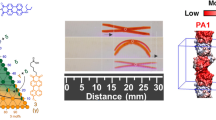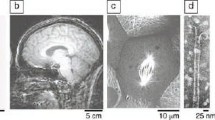Abstract
This article addresses why biomaterials are a growing part of materials science. We consider two areas at two different scales. At the nanometer scale, enzymes are heterogeneous nanoparticles of extraordinary deformability; this property allows us to view biomolecules informed by concepts of materials science and nonlinear physics. A degree of universality in the mechanical behavior of the molecules appears in the ubiquitous softening transitions; some results obtained dynamically by nanorheology, and others obtained in equilibrium experiments through the method of the DNA springs are summarized. These soft molecules represent an opportunity for studies of dissipation at the atomic scale. At the mesoscopic scale, composite functional materials with biological components hold promise for applications such as low power, chemically driven, biodegradable devices. A concrete example, and a program for the future, is the artificial axon. It is a synthetic structure that supports action potentials based on the same physical mechanism as the voltage spikes in nerve cells. A network of such axons, which is yet to come, would constitute an artificial brain. Beyond device applications, the focus here is on the basic science, namely, a constructivist approach to cybernetics, algorithmic mathematics, and the brain.




Similar content being viewed by others
References
E. Drexler, C. Peterson, G. Pergamit, Unbounding the Future: The Nanotechnology Revolution (William Morrow, New York, 1991).
F. Huber, J. Schnauß, S. Rönicke, P. Rauch, K. Müller, C. Fütterer, J. Käs, Adv. Phys. 62, 1 (2013).
B.H. McMahon, F.G. Parak, P.W. Fenimore, H. Frauenfelder, Proc. Natl. Acad. Sci. U.S.A. 99, 16047 (2002).
H. Frauenfelder, G. Chen, J. Berendzen, P.W. Fenimore, H. Jansson, B.H. McMahon, I.R. Stroe, J. Swenson, R.D. Young, Proc. Natl. Acad. Sci. U.S.A. 106, 5129 (2009).
L. Wanga, Y. Qina, D. Zhong, Proc. Natl. Acad. Sci. U.S.A. 113, 8424 (2016).
J. Yang, Y. Wang, L. Wang, D. Zhong, J. Am. Coll. Surg. 139, 4399 (2017).
G. Zocchi, Molecular Machines, a Materials Science Approach (Princeton University Press, Princeton, NJ, 2018).
D.E. Koshland Jr., Proc. Natl. Acad. Sci. U.S.A. 44, 98 (1958).
T.A. Steitz, W.F. Anderson, R.J. Fletterick, C.M. Anderson, J. Biol. Chem. 252, 4494 (1977).
W.S. Bennett, T.A. Steitz, Proc. Natl. Acad. Sci. U.S.A. 75, 4848 (1978).
B. Choi, G. Zocchi, S. Canale, Y. Wu, S. Chan, L.J. Perry, Phys. Rev. Lett. 94, 038103 (2005).
Y. Wang, G. Zocchi, Phys. Rev. Lett. 105, 238104 (2010).
D.R. Hekstra, K.I. White, M.A. Socolich, R.W. Henning, V. Šrajer, R. Ranganathan, Nature 540, 400 (2016).
C.-Y. Tseng, A. Wang, G. Zocchi, Europhys. Lett. 91, 18005 (2010).
C.-Y. Tseng, G. Zocchi, J. Am. Coll. Surg. 135, 11879 (2013).
Y. Wang, G. Zocchi, Europhys. Lett. 96, 18003 (2011).
Y. Wang, G. Zocchi, PLoS One 6 (12), e28097 (2011).
A. Ariyaratne, C. Wu, C.-Y. Tseng, G. Zocchi, Phys. Rev. Lett. 113, 198101 (2014).
H. Qu, J. Landy, G. Zocchi, Phys. Rev. E Stat. Nonlin. Soft Matter Phys. 86, 041915 (2012).
H. Qu, G. Zocchi, Europhys. Lett. 94, 18003 (2011).
T. Dauxois, Phys. Today 61, 55 (2008).
Z. Alavi, G. Zocchi, Phys. Rev. E Stat. Nonlin. Soft Matter Phys. 97, 052402 (2018).
P.W.K. Rothemund, Nature 440, 297 (2006).
W.M. Shih, J.D. Quispe, G.F. Joyce, Nature 427, 618 (2004).
J. Chen, N.C. Seeman, Nature 350, 631 (1991).
A. Ariyaratne, G. Zocchi, J. Phys. Chem. B 120, 6255 (2016).
H.G. Vasquez, G. Zocchi, Europhys. Lett. 119, 48003 (2017).
C.M. O’Brien, B. Holmes, S. Faucett, L.G. Zhang, Tissue. Eng. Part B Rev. 21 (1), 103 (2015).
M. Thomas, S.M. Willerth, Front. Bioeng. Biotechnol. 5, 69 (2017).
D. Espinosa-Hoyos, A. Jagielska, K.A. Homan, H. Du, T. Busbee, D.G. Anderson, N.X. Fang, J.A. Lewis, K.J. Van Vliet, Sci. Rep. 8, 478 (2018).
V. Braitenberg, Vehicles (MIT Press, Cambridge, MA, 1984).
H.G. Vasquez, G. Zocchi, Bioinspir. Biomim. 14, 016017 (2019).
Author information
Authors and Affiliations
Corresponding author
Rights and permissions
About this article
Cite this article
Zocchi, G. Opportunities for materials science: From molecules to neural networks. MRS Bulletin 44, 124–129 (2019). https://doi.org/10.1557/mrs.2019.23
Published:
Issue Date:
DOI: https://doi.org/10.1557/mrs.2019.23




